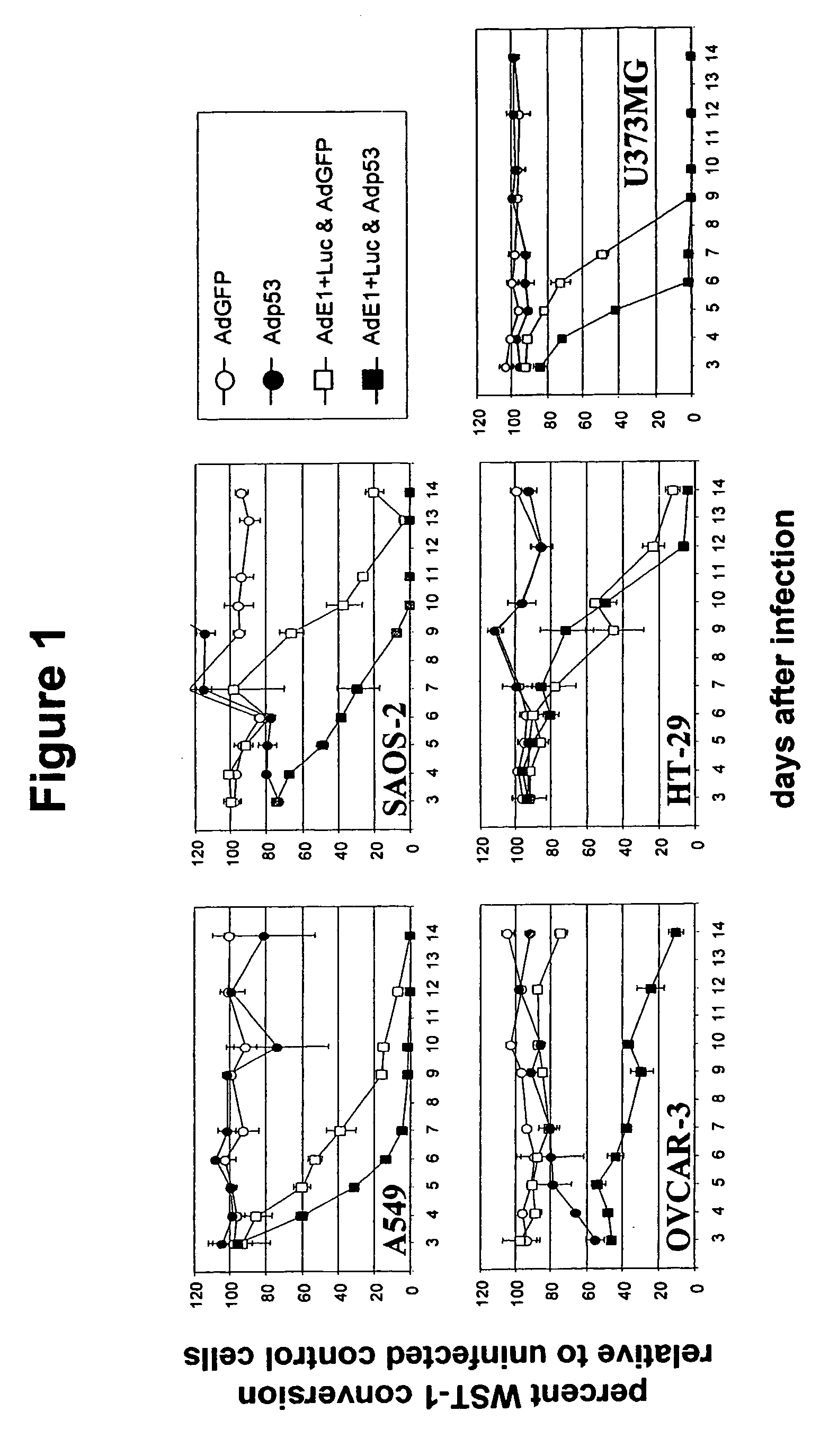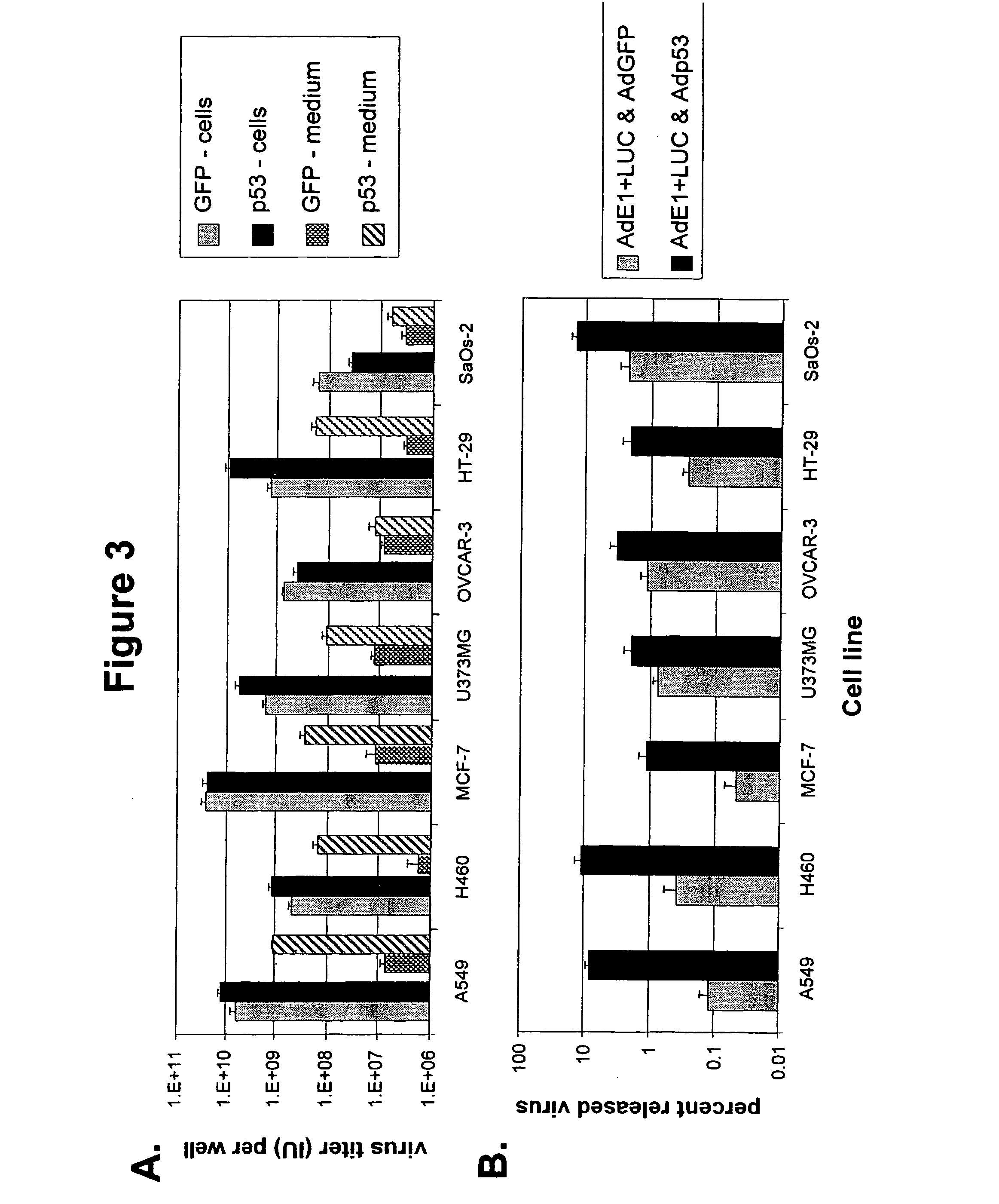Viruses with enhanced lytic potency
- Summary
- Abstract
- Description
- Claims
- Application Information
AI Technical Summary
Benefits of technology
Problems solved by technology
Method used
Image
Examples
example 1
Production of Replication-Competent and Conditionally Replicating Adenoviruses Expressing the Human Tumor Suppressor Protein p53 and Control Adenoviruses without p53
[0086] To construct adenoviruses with an expression cassette for human p53 in place of the E3 region, the SVE-p53 expression cassette (SV40 early promoter-driven human p53 cDNA including intron-4) was released from pAdHumPwt.SVE (Ameyar et al., Oncogene 18(1999):5464-5472) by digestion with KpnI and XbaI (partial). The 2.6 kb fragment was inserted into KpnI / XbaI-digested pABS.4 (Microbix Biosystems, Toronto, Canada). The resulting construct was designated pABS.4-p53. pABS.4-p53 was digested with PacI and the 4 kb fragment carrying the SVE-p53 cassette and kanamycin resistance gene was inserted into PacI-digested pBHG11 (Microbix Biosystems). A clone with an insert in the orientation that places the SVE-p53 cassette on the adenovirus 1-strand was isolated and designated pBHG11-p53kan-L. The kanamycin resistance gene was ...
example 2
Expression of Functional p53 Protein in Adenovirus-Infected Cells Enhances Cell Lysis
[0089] To demonstrate that expression of a functional component of the p53-dependent apoptosis pathway during adenovirus replication augments lysis of the host cell, a dual-virus system was used in which cells were infected with equal amounts of the replication-competent adenovirus AdE1+Luc (a kind gift of Dr. R. Vogels, Crucell Holland B V, Leiden, The Netherlands) that was derived from wild-type Ad5 through replacement of the gp19k open reading frame in the E3 region by the firefly luciferase gene, and the replication-defective vector Adp53 (Ameyar et al., Oncogene 18(1999):5464-5472), expressing human wild-type p53 protein. This dual-virus system creates a situation where p53 is expressed in the context of a replicating adenovirus. As a negative control, Adp53 was replaced by the irrelevant control vector AdGFP (expressing CMV promoter-driven Enhanced Green Fluorescent Protein; van Beusechem et ...
example 3
Expression of Functional p53 Protein in Adenovirus-Infected Cells Accelerates the Release of Progeny Virus
[0091] To demonstrate that the augmented cell lysis due to expression of a functional component of the p53-dependent apoptosis pathway during adenovirus replication results in an earlier release of virus progeny, the same dual-virus infection experiment was performed as described in example 2 and at various time-points during the 14-day culture period the AdE1+Luc virus titer was determined in the culture medium of dual-virus infected cells. To this end, the culture medium was harvested and cleared by centrifugation. The cell-free supernatant was serially diluted in F12-DMEM / 10% FCS and used to infect A549 cells seeded 104 cells / well in 96-well plates 24 hours before infection. A control titration of AdE1+Luc virus with known pfu titer was included. After 20-24 hours, the culture medium was replaced by Luciferase Chemiluminescent Assay System Reporter Lysis Buffer (Promega, Mad...
PUM
| Property | Measurement | Unit |
|---|---|---|
| Toxicity | aaaaa | aaaaa |
| Cell growth | aaaaa | aaaaa |
Abstract
Description
Claims
Application Information
 Login to View More
Login to View More - R&D
- Intellectual Property
- Life Sciences
- Materials
- Tech Scout
- Unparalleled Data Quality
- Higher Quality Content
- 60% Fewer Hallucinations
Browse by: Latest US Patents, China's latest patents, Technical Efficacy Thesaurus, Application Domain, Technology Topic, Popular Technical Reports.
© 2025 PatSnap. All rights reserved.Legal|Privacy policy|Modern Slavery Act Transparency Statement|Sitemap|About US| Contact US: help@patsnap.com



